Smew
| Smew | |
|---|---|
 | |
| Male (top) and female smew | |
| Scientific classification | |
| Kingdom: | Animalia |
| Phylum: | Chordata |
| Class: | Aves |
| Order: | Anseriformes |
| Family: | Anatidae |
| Subfamily: | Merginae |
| Genus: | Mergellus Selby, 1840 |
| Species: | M. albellus |
| Binomial name | |
| Mergellus albellus (Linnaeus, 1758) | |
| Synonyms | |
|
Mergus albellus | |
The smew (Mergellus albellus) is a species of duck, and is the only living member of the genus Mergellus. Mergellus is a diminutive of Mergus and albellus is from Latin albus "white".[2] This genus is closely related to Mergus and is sometimes included in it, though it might be closer to the goldeneyes (Bucephala).[3] The smew has interbred with the common goldeneye (B. clangula).[4]
A seaduck fossil from the Middle Miocene shows that birds similar to smew existed up to 13 million years ago. The extant species dates back to the Pleistocene.
Description
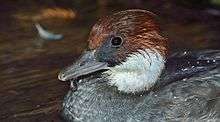
The drake smew, with its 'cracked ice' and 'panda' appearance, is unmistakable, and looks very black-and-white in flight. The females and immature males are grey birds with chestnut foreheads and crowns, and can be confused at a distance with the ruddy duck; they are often known as "redhead" smew. It has oval white wing-patches in flight. The smew's bill has a hooked tip and serrated edges, which help it catch fish when it dives for them.
The smew is 38–44 cm (15–17 in) long.[4]
Distribution and ecology
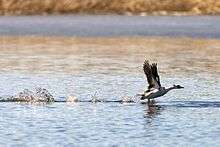
This species breeds in the northern taiga of Europe and Asia. It needs trees for breeding. The smew lives on fish-rich lakes and slow rivers. As a migrant, it leaves its breeding areas and winters on sheltered coasts or inland lakes of the Baltic Sea, the Black Sea, northern Germany and the Low Countries, with a small number reaching Great Britain (for example, at Dungeness), mostly at regular sites. Vagrants have been recorded in North America. On lakes it prefers areas around the edges, often under small trees. The smew breeds in May and lays 6–9 cream-colored eggs. It nests in tree holes, such as old woodpecker nests. It is a shy bird and flushes easily when disturbed.
The smew is one of the species to which the Agreement on the Conservation of African-Eurasian Migratory Waterbirds (AEWA) applies. It is not considered threatened on the IUCN Red List, though its population is decreasing.[1]
Fossil history
An unnamed fossil seaduck, known from a humerus found in the Middle Miocene Sajóvölgyi Formation (Late Badenian, 13–12 million years ago) of Mátraszõlõs, Hungary, was assigned to Mergus. However, the authors included the smew therein, and consequently, the bone is more properly assigned to Mergellus—especially as it was more similar to a smew's than to the Bucephala remains also found at the site. It is sometimes argued[5] that the Mátraszõlõs fossil is too old to represent any of the modern seaduck genera, but apparently these were all well-distinct even back then.[6]
Fossils from the earliest Pleistocene found in England indicate that the living species was extant 1.5 to 2.0 million years ago.[5]
Gallery
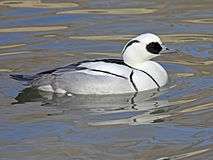 Male
Male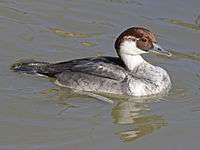 Female
Female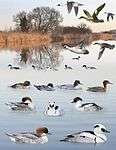 ID composite
ID composite
References
- 1 2 BirdLife International (2012). "Mergellus albellus". IUCN Red List of Threatened Species. Version 2013.2. International Union for Conservation of Nature. Retrieved 26 November 2013.
- ↑ Jobling, James A (2010). The Helm Dictionary of Scientific Bird Names. London: Christopher Helm. pp. 38, 251. ISBN 978-1-4081-2501-4.
- ↑ Livezey, Bradley C. (1986). "A phylogenetic analysis of recent anseriform genera using morphological characters" (PDF). Auk. 103 (4): 737–754. JSTOR 4088089.
- 1 2 Madge, Steve; Burn, Hilary (1988). Waterfowl: An Identification Guide to the Ducks, Geese, and Swans of the World. Boston: Houghton Mifflin. pp. 274–276. ISBN 0-395-46727-6.
- 1 2 Mlíkovský, Jiří (2002). Cenozoic Birds of the World, Part 1: Europe (PDF). Prague: Ninox Press. p. 123. ISBN 80-901105-3-8.
- ↑ Gál, Erika; Hír, János; Kessler, Eugén; Kókay, József (1998–99). "Középsõ-miocén õsmaradványok, a Mátraszõlõs, Rákóczi-kápolna alatti útbevágásból. I. A Mátraszõlõs 1. lelõhely" [Middle Miocene fossils from the sections at the Rákóczi chapel at Mátraszőlős. Locality Mátraszõlõs I.] (PDF). Folia Historico Naturalia Musei Matraensis (in Hungarian and English). 23: 33–78.
External links
| Wikimedia Commons has media related to Mergellus albellus. |
| Wikispecies has information related to: Mergellus albellus |
- BirdLife species factsheet for Mergellus albellus
- "Mergellus albellus". Avibase.

- "Smew media". Internet Bird Collection.
- Smew photo gallery at VIREO (Drexel University)
- Interactive range map of Mergellus albellus at IUCN Red List maps
- Audio recordings of Smew on Xeno-canto.
